
Home About Us Contact Us Subscribe

Home About Us Contact Us Subscribe
|
|
|
|
Exhibition: Ecology, Economy, Equity: The Architecture of William McDonough + Partners at the Atlanta International Museum
"Being less bad is not being good" is a tune we all should learn. by Kristen Richards October 15, 2002 “Imagine the most
high-tech building possible, and then consider this design assignment: Design a
building that makes oxygen, sequesters carbon, fixes nitrogen, distills water,
provides habitat for thousands of species, accrues solar energy as fuel and
food, builds soil, generates microclimate, changes with the seasons, and
creates delight.” ● William McDonough, FAIA In the growing field of ecologically intelligent design,
the firm of William McDonough +
Partners (WMP) has been a pioneer and leading practitioner in opening the
way for a new generation of architects and designers – and consumers –
regarding what was once rather sniffingly called “green design.” At the helm,
there really is the impassioned Bill McDonough, backed by a team of partners,
associates, and staff no less impassioned. It’s difficult to imagine any
treatise on “green design” not referring to WMP projects and studies over the
last two decades. Perhaps the most mainstream acknowledgment came from Time
magazine in 1999, when Bill McDonough was recognized as a “Hero for the Planet”
in a cover story, The
Man Who Wants Buildings to Love Kids. The Atlanta International Museum
is hosting the first major retrospective of WMP projects called “Ecology,
Economy, Equity: The Architecture of
William McDonough + Partners” through February 28, 2003. The exhibition
features architectural models, text panels, preparatory drawings, site plans,
an “eartharium,” and interactive computer stations that detail projects
including the Herman Miller "GreenHouse" Factory and Offices; the
Adam Joseph Lewis Center for Environmental Studies at Oberlin College; and the Museum of Life and the
Environment, a project currently in design in York County, South Carolina,
which will be a unique combination of cultural and natural history. Instead of
limiting ourselves, McDonough suggests we should marshal our design
intelligence to fulfill our needs differently. This exhibition explores avenues
of applicable expressions to find increased understanding of this "second
industrial revolution.” In their
work, McDonough and his colleagues ask how the human footprint may have a
wholly beneficial impact on the environment. Instead of using less energy,
buildings can produce energy. Instead of reducing waste, design can eliminate
the concept of waste. Instead of making materials less harmful, designers can
use materials that improve human health. This approach, which McDonough calls
"eco-effective," measures success equally in three areas: ecology,
economy, and equity. The architecture of William McDonough + Partners
successfully demonstrates that healthy, humane design can be environmentally,
financially, and socially productive, as well as aesthetically uplifting.
Inspired by the abundance of nature, in which growth is good and waste does not
exist, these buildings are rich with daylight, fresh air, and the larger
landscape. They point the way to the "next industrial revolution," in
which all design will celebrate life. This work is meant as much for future
generations as for our own. "Given the mission of the museum to address art and
design of world culture, we are excited to have a chance to address evolving
themes of ecological design through an exhibit of our recent work," says Chris Hays, one of three design
partners with the firm. "Being blessed with a rich diversity of project
types and insightful clients has allowed us to delve into environmental issues
that are relevant to global discussions while simultaneously responding very
specifically to the places we build. We hope the exhibit will not only raise
challenging questions, but will also demonstrate that through research and the
creative process, ecologically effective solutions are possible." Over the
last few decades, the environmental movement has expanded to affect virtually
every area of human activity. Global warming, deforestation, and other
consequences of industrial society have become part of our collective
awareness. At the turn of the millennium, these concerns are bringing about a
sea change in the field of architecture. An enormous amount of material and
energy are required to construct, operate and maintain buildings, which,
according to WMP, account for 40 percent of American energy use, 10-15 percent
of the Gross Domestic Product, and 25 percent of the global wood harvest. The
construction industry is a significant arena in which to improve upon
environmental performance, and such efforts have come to be known as
"sustainable" or "green" architecture. While
sustainability typically is characterized by negative or neutral standards that
define what not to do, McDonough and his collaborators have distinguished
themselves by diligently pursuing a hopeful, positive agenda.
"Eco-efficiency," a guiding principle of conventional sustainable
practice, means "doing more with less": use fewer resources, reduce
pollution and waste, and minimize damage to human health and the environment.
Yet, this agenda seeks only to mitigate existing problems, not eliminate them.
In McDonough's words, "Being less bad is not being good." This new industrial revolution involves thoughtful design
that is sustaining, not just sustainable, and is the principle behind MBDC (McDonough Braungart Design Chemistry), an
industrial design firm – or more precisely – a product and process design firm
co-founded by William McDonough and German chemist Dr. Michael Braungart. Their
book, “Cradle
to Cradle: Remaking the Way We Make Things,” embraces abundance, human
ingenuity, and positive aspirations. It proposes a positive new design strategy
based on principles seen in nature: waste equals food, use current solar
income, and celebrate diversity. They present a new industrial system, modeled
on the nature's principles, that can solve rather than minimize the problems
industry creates, allowing both business and nature to thrive and grow. A pipe dream? We think not. The Atlanta International Museum’s Artistic Director,
Angelyn S. Chandler says, “We have received an outpouring of support and
interest from the community with this timely subject. The work in this
exhibition moves beyond ‘smart growth’ or energy savings to inspire a new way
of thinking about design.” A free public event on November 7, “Leadership
& Legacy: Eco-effective Commerce Can Be Profitable,” will be a panel
discussion with local industry leaders including Bob
Hascall, Emory University; Pam Sessions, Hedgewood Properties; Ray Anderson, Interface, Inc.; and R. Jeff George, Hardin
Construction; and moderated by Dennis Creech, Southface Energy Institute. Projects illustrated: Aspect Communications, San Jose, CA Client: Aspect Communications Program: Office Building, Parking, Amenities Area: 110,000 square feet Status: Completed 2001 Architect of Record: Form4 Design Landscape Architect: Nelson-Byrd Landscape Architects Landscape Architect of Record: April Phillips Design Workshop Photograph: © Steve Whittaker Nike European Headquarters, Hilversum, Netherlands Client: Nike, Multi-Vastgoed Program: Corporate campus including offices, commons, health and fitness amenities, gymnasium/videoconference hall, retail space, and restaurants Area: 375,000 square feet Status: Completed 1999 Architect of Record: T+T Architekten B.V. Landscape Architect: Nelson-Byrd Landscape Architects Photograph courtesy William McDonough + Partners Bear Street, Banff, Alberta, Canada Client: Arctos & Bird Program: Mixed-use retail and residential Area: 35,000 square feet Status: Under construction Architect of Record: Zeidler Carruthers Associates Design Landscape Architect: VMDO Landscape Studio Landscape Architect of Record: Scatliff + Miller + Murphy Drawing by Pete O’Shea, ASLA 901 Cherry, Offices for GAP, Inc., San Bruno, CA Client: Gap Inc. Program: Corporate campus and offices Project Area: 195,000 square feet Status: Completed 1997 Executive Architect & Interior Design Architect: Gensler Landscape Architect: Hargreaves Associates Exterior photograph courtesy William McDonough + Partners; Interior photograph © Mark Luthringer Herman Miller SQA “Greenhouse” Holland, MI Client: Herman Miller SQA Program: Light manufacturing and offices Area: 295,000 square feet Status: Completed 1995 Architect of Record: Verburg & Associates Landscape Architect: Pollack Design Associates Photograph: © Tim Hursley Lewis Center for Environmental Studies, Oberlin College Oberlin, OH Client: Oberlin College Program: Classrooms, offices, atrium, and auditorium Area: 13,600 square feet Status: Completed 2001 Landscape Architect: Andropogon Associates Photograph: © Barney Taxel Museum of Life and the Environment York County, SC Client: York County Culture & Heritage Commission Program: Exhibit space, classrooms, & administration Area: 120,000 square feet Status: Schematic Design Landscape Architect: Nelson-Byrd Exhibition Designer: Ralph Applebaum Associates Rendering courtesy William McDonough + Partners Virginia Beach House, Virginia Beach, VA Program: Private residence Area: 11,000 square feet Status: Completed 2001 Landscape Architect: Nelson-Byrd Landscape Architects Photograph: © Prakash Patel |
(click on pictures to enlarge) 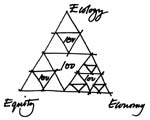 (William McDonough + Partners (WMP)) Ecology, Economy, Equity: all equal parts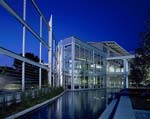 ((c) Steve Whittaker) Aspect Communications, San Jose, CA, 2001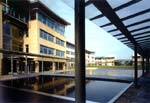 (WMP) Nike European Headquarters, Hilversum, Netherlands, 1999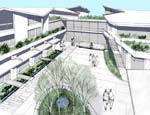 (Drawing by Pete O'Shea, ASLA) Bear Street, Banff, Alberta, Canada, under construction (WMP) 901 Cherry, Offices for GAP, Inc., San Bruno, CA, 1997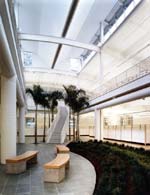 ((c) Mark Luthringer.) 901 Cherry, Offices for GAP, Inc. interior ((c) Tim Hursley) Herman Miller SQA "Greenhouse," Holland, MI, 1995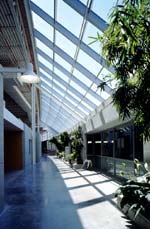 ((c) Tim Hursley) Herman Miller SQA "Greenhouse," Holland, MI, 1995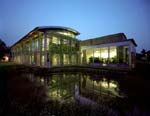 ((c) Barney Taxel) Lewis Center for Environmental Studies, Oberlin College, Oberlin, OH, 2001 (WMP) Museum of Life and the Environment, York County, SC, schematic design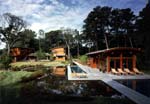 ((c) Prakash Patel) Virginia Beach House, Virginia Beach, VA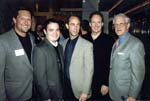 (Jeff Slate) Sponsors and architects opening night at the Atlanta International Museum (l-r): Jeff Bartholomew, Steelcase; Flavio Espinoza, Chris Hays, Bill McDonough, WM+P; Inman Allen, Ivan Allen Furniture Co.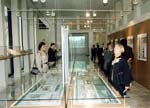 (Jeff Slate) Exhibition gallery (Atlanta International Museum) Exhibition cover |
© 2002 ArchNewsNow.com